In graphs: How gentrification has changed Berlin

Berlin will likely freeze its rental prices for five years to combat rapidly rising rates. We explore, in graphs, just how the capital has been affected by gentrification.
When I first moved to Berlin in 2012, I quickly found a reasonably priced flat in the neighborhood of Wedding, located just north of the central Mitte.
Having moved from San Francisco, now the most expensive city in the US, I marvelled to friends and family how, in Berlin, I could pay the same amount for a spacious apartment with two sunlit rooms and a patio as I could for a cramped "closet" back home.
Seven years later, Berlin may still be quite an affordable city compared to the major metropolitan hubs of the world.
But there’s no denying that the once famously dubbed “Poor, but sexy” city is quickly changing in price - and with it, its character.
The rapid rise of prices - which has more than doubled in some neighborhoods in the past 10 years - is what has led Berlin's Senate to call for a five year freeze on rental prices.
SEE ALSO: Berlin opts to freeze rental prices for five years
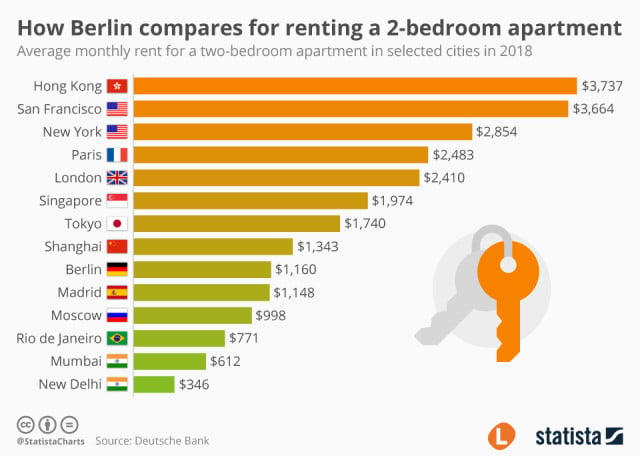
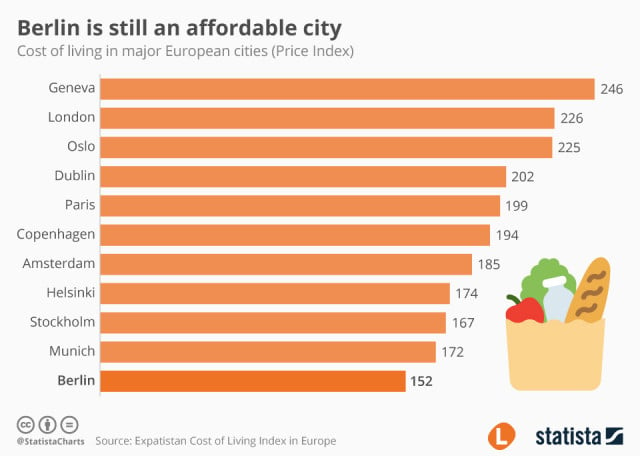
Graphs, both from 2018, prepared for The Local by Statista.
In my three initial years living in Wedding, I noticed an increase in coffee shops with soy milk lattes, Bio shops and pubs selling specialty brewed craft beers. Where I once heard only chatter in German or Turkish, I listened in on banter in English - and several other languages, too.
By the time I left my Kiez - unable to find anything else affordable nearby after my sublet expired - I was being invited to events around the corner rather than travelling across the city to more “happening” hubs like Neukölln or Kreuzberg.
Wedding, too, had been hit by Berlin’s spiraling gentrification. In 2013 housing costs as a share of purchasing power were 20.8 percent as opposed to 25.6 percent in 2016.
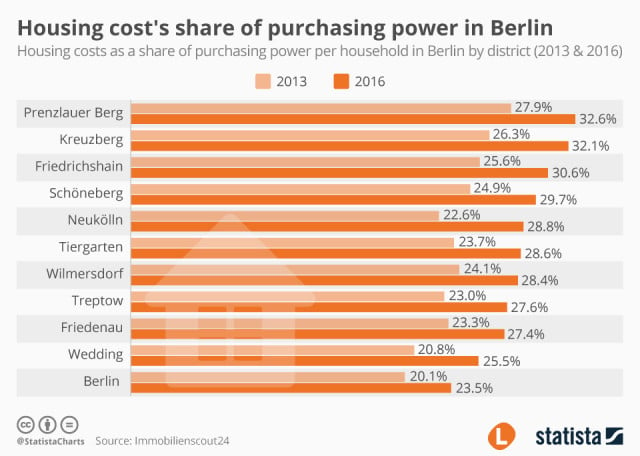
Graph prepared for The Local by Statista
Hubs for artists
By 2018, rent in Mitte and Wedding reached an average of €12.51 per square metre, with only the neighbourhoods of Friedrichshain and Kreuzberg slightly higher at €12.94 per square metre.
The two graffiti-laden neighbourhoods - one in the former east and the other right along the border of it - have for a long time been known for their artsy and alternative vibe.
But in the past years, they have had a particular pull on foreigners with fresh ideas, be it bohemian boutiques, studios or former factories turned into techie hubs for creative projects.
That's why the following graph is indicative of gentrification, with the areas where artists set up shop corresponding with places that have higher rents.
A total 1,745 artists with an average age of 47 took part in the 2018 study. The participating artists took part in more than 13,000 exhibitions in the last three years, 40 percent which took place in Berlin.
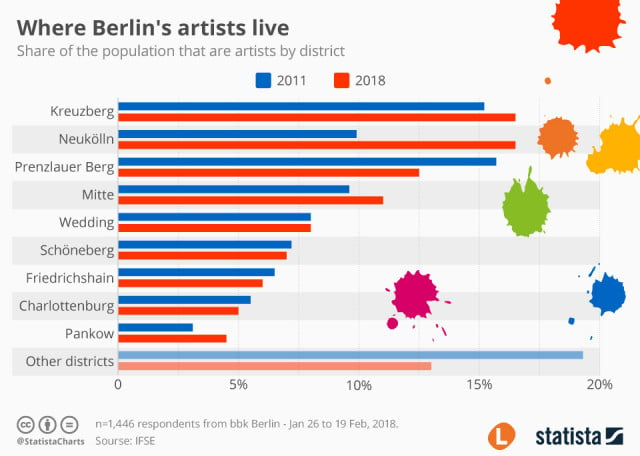
Graph prepared for The Local by Statista
Still affordable spots
On an optimistic note, there are still several parts of Berlin which remain affordable. After Wedding, I relocated slightly outside of the Ringbahn to Lichtenberg in the former East.
SEE ALSO: People think life in Berlin ends outside of the Ringbahn. They're wrong.
As of April 2019, it remains one of the more affordable parts of Berlin - nearly half the cost of Berlin's most most expensive Kiez of Kreuzberg.
Yet in my two years there, I noticed much of the same phenomenon: as prices rose in the nearby neighbourhood of Friedrichshain, and more younger people and international businesses seemed to set up shop in little Lichtenberg.
Looking for another flat there two years ago in the summer amid Fête de la Musique - a citywide music festival - I thought I had accidentally turned up at a concert as crowds of people took turns pouring into a tiny studio.
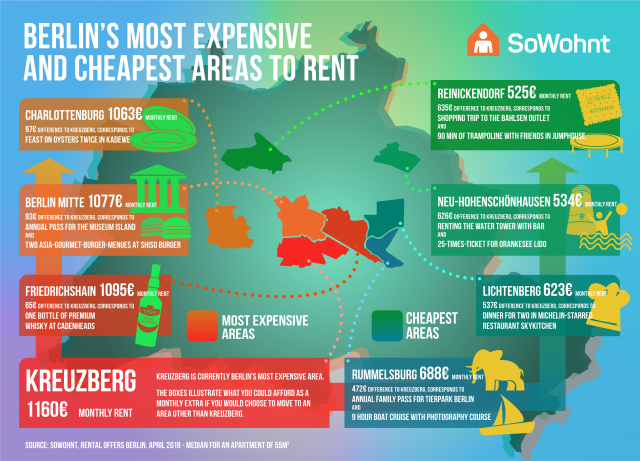
Graph translated for The Local by rental platform Sowohnt
Highest and lowest rents
In 2018, Lichtenberg was also seen as affordable. Rent was €9.53 per square metre, as opposed to €12.51 per square metre in Friedrichshain-Kreuzberg.
Now, just a year later, as I'm amidst the hopefully not fruitless search for a new flat, I'm seeing several prices that don't remind me of Berlin. But just what do 'Berlin prices' mean anymore?
More and more housing websites to accommodate the influx of newcomers continue sprouting up, offering housing at prices that would have been unheard of just a few years ago.
As I look for another place to live now - amid ever-rising competition and rates - I wonder if there's anywhere in the capital truly exempt from spiraling gentrification.
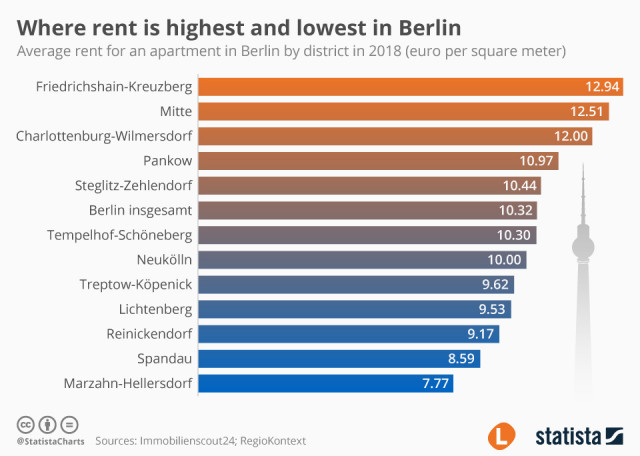
Graph prepared for The Local by Statista.
As a relative newcomer myself who appreciates soy lattes, I can't say that change is always bad, or that I'm not part of the demographic that's contributed to it myself.
Yet Berlin should have a way to accommodate both the newbie Wahlberliner (Berliners by choice) and those who were born here. Whether a price freeze in some housing can or will accomplish this remains to be seen.
Comments
See Also
When I first moved to Berlin in 2012, I quickly found a reasonably priced flat in the neighborhood of Wedding, located just north of the central Mitte.
Having moved from San Francisco, now the most expensive city in the US, I marvelled to friends and family how, in Berlin, I could pay the same amount for a spacious apartment with two sunlit rooms and a patio as I could for a cramped "closet" back home.
Seven years later, Berlin may still be quite an affordable city compared to the major metropolitan hubs of the world.
But there’s no denying that the once famously dubbed “Poor, but sexy” city is quickly changing in price - and with it, its character.
The rapid rise of prices - which has more than doubled in some neighborhoods in the past 10 years - is what has led Berlin's Senate to call for a five year freeze on rental prices.
SEE ALSO: Berlin opts to freeze rental prices for five years


Graphs, both from 2018, prepared for The Local by Statista.
In my three initial years living in Wedding, I noticed an increase in coffee shops with soy milk lattes, Bio shops and pubs selling specialty brewed craft beers. Where I once heard only chatter in German or Turkish, I listened in on banter in English - and several other languages, too.
By the time I left my Kiez - unable to find anything else affordable nearby after my sublet expired - I was being invited to events around the corner rather than travelling across the city to more “happening” hubs like Neukölln or Kreuzberg.
Wedding, too, had been hit by Berlin’s spiraling gentrification. In 2013 housing costs as a share of purchasing power were 20.8 percent as opposed to 25.6 percent in 2016.

Graph prepared for The Local by Statista
Hubs for artists
By 2018, rent in Mitte and Wedding reached an average of €12.51 per square metre, with only the neighbourhoods of Friedrichshain and Kreuzberg slightly higher at €12.94 per square metre.
The two graffiti-laden neighbourhoods - one in the former east and the other right along the border of it - have for a long time been known for their artsy and alternative vibe.
But in the past years, they have had a particular pull on foreigners with fresh ideas, be it bohemian boutiques, studios or former factories turned into techie hubs for creative projects.
That's why the following graph is indicative of gentrification, with the areas where artists set up shop corresponding with places that have higher rents.
A total 1,745 artists with an average age of 47 took part in the 2018 study. The participating artists took part in more than 13,000 exhibitions in the last three years, 40 percent which took place in Berlin.

Graph prepared for The Local by Statista
Still affordable spots
On an optimistic note, there are still several parts of Berlin which remain affordable. After Wedding, I relocated slightly outside of the Ringbahn to Lichtenberg in the former East.
SEE ALSO: People think life in Berlin ends outside of the Ringbahn. They're wrong.
As of April 2019, it remains one of the more affordable parts of Berlin - nearly half the cost of Berlin's most most expensive Kiez of Kreuzberg.
Yet in my two years there, I noticed much of the same phenomenon: as prices rose in the nearby neighbourhood of Friedrichshain, and more younger people and international businesses seemed to set up shop in little Lichtenberg.
Looking for another flat there two years ago in the summer amid Fête de la Musique - a citywide music festival - I thought I had accidentally turned up at a concert as crowds of people took turns pouring into a tiny studio.

Graph translated for The Local by rental platform Sowohnt
Highest and lowest rents
In 2018, Lichtenberg was also seen as affordable. Rent was €9.53 per square metre, as opposed to €12.51 per square metre in Friedrichshain-Kreuzberg.
Now, just a year later, as I'm amidst the hopefully not fruitless search for a new flat, I'm seeing several prices that don't remind me of Berlin. But just what do 'Berlin prices' mean anymore?
More and more housing websites to accommodate the influx of newcomers continue sprouting up, offering housing at prices that would have been unheard of just a few years ago.
As I look for another place to live now - amid ever-rising competition and rates - I wonder if there's anywhere in the capital truly exempt from spiraling gentrification.

Graph prepared for The Local by Statista.
As a relative newcomer myself who appreciates soy lattes, I can't say that change is always bad, or that I'm not part of the demographic that's contributed to it myself.
Yet Berlin should have a way to accommodate both the newbie Wahlberliner (Berliners by choice) and those who were born here. Whether a price freeze in some housing can or will accomplish this remains to be seen.
Join the conversation in our comments section below. Share your own views and experience and if you have a question or suggestion for our journalists then email us at [email protected].
Please keep comments civil, constructive and on topic – and make sure to read our terms of use before getting involved.
Please log in here to leave a comment.